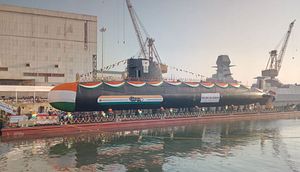India has launched the third of six planned Scorpene-class (Kalvari-class) diesel-electric attack submarines (SSK) for the Indian Navy at the naval dockyard in Mumbai on January 31, the Indian Ministry of Defense (MoD) announced today.
The new 1,565-ton submarine, christened Karanj, will now undergo extensive harbor and sea trials before entering service with the Indian Navy sometime in 2019.
In 2005, French shipbuilder Direction des Constructions Navales Services (DCNS), was awarded a $4.16 billion contract by the Indian government to build six SSKs for the Indian Navy in cooperation with India’s major shipbuilder, Mumbai-based Mazagon Dock Limited, under the Project-75 acquisition program.
The lead boat of the class, INS Kalvari, was commissioned in December 2017 in the presence of Indian Prime Minister Narendra Modi. The second submarine of the class, Khanderi, began seal trials in June 2017 and is expected to be commissioned in the coming months. The last submarine of the class is slated for induction in 2020.
“The state-of- the-art technology utilized for construction of the Scorpene class submarines has ensured superior stealth features such as advanced acoustic silencing techniques, low radiated noise levels, hydro-dynamically optimized shape and the ability to launch a crippling attack on the enemy using precision guided weapons,” the MoD notes in a January 31st press statement.
The new SSKs will be armed with French-made Exocet SM39 anti-ship missile, a sea-skimming, subsonic, solid-fueled anti-ship missile with an estimated operational range of 50-70 kilometers, designed to attack small- to medium-size warships, as well as heavy-weight torpedoes. Kalvari-class subs are able to carry up to 18 anti-ship missiles or heavy-weight torpedoes.
As of now, however, the Indian Navy does not possess modern heavyweight torpedoes as it had to cancel an order for 98 Black Shark torpedoes in 2017 following a corruption scandal. The service is currently evaluating German SeaHake and French F21 Artemis heavyweight torpedoes as replacements.
The new SSK, despite reports to the contrary, has not been fitted with an air-independent propulsion (AIP) system, although there are plans to retrofit all subs of the class with a domestically designed and built AIP in the future.
The SSKs, powered by two 1250 kW MAN diesel engines, have an operational range of around 6,500 nautical miles (around 12,000 kilometers).
Interestingly, the Indian Navy has decided to abandon plans to place a follow-up order for six additional Kalvari-class boats with DCNS, as I reported previously (See: “India Drops Plans to Add 3 More French Stealth Attack Submarines”):
With DCNS apparently out of the competition for the next phase of Project 75-I, India will have to look among the French ship maker’s competitors – including Navantia (Spain), Kockums (Sweden), Rubin Design Bureau-Amur Shipyard (Russia), Mitsubishi Heavy Industries, and Kawasaki Heavy Industries (Japan) – to choose a foreign defense contractor to build an additional six diesel-electric attack submarines in Mumbai.
Nonetheless, a so-called acceptance of necessity (AON), the first step in India’s complicated defense procurement process, issued by the Indian government for the $11 billion Project 75-I, will likely expire on February 6 without the selection of an Indian shipyard and a foreign ‘strategic partner.’ The AON is expected to be reissued.
































